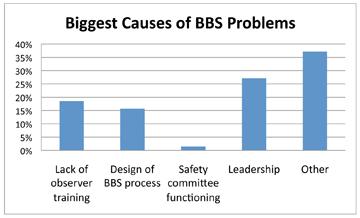

n the realm of workplace safety, Behavior-Based Safety (BBS) programs stand out as powerful tools for preventing incidents and fostering a culture of continuous improvement. While many organizations have implemented BBS, there’s always room for enhancement to ensure its sustained success. But even the most well-intentioned BBS initiatives can benefit from a tune-up. This comprehensive guide explores strategies and best practices to elevate your BBS program, turning it into a robust framework that not only identifies unsafe behaviors but actively promotes a safer workplace
To improve any BBS program, it’s crucial to grasp its fundamental principles. BBS focuses on observing and addressing at-risk behaviors by engaging the workforce and fostering a collective commitment to safety. Recognizing these core tenets sets the stage for effective enhancements.
Sure, your BBS program might excel at pinpointing unsafe actions. But the true ascent lies in transitioning from observers to motivators. Here’s how:

A successful BBS program isn’t just about rules and checklists; it’s about fostering a collective sense of responsibility for safety. Here’s how to build that foundation:
Numbers might not tell the whole story, but they can illuminate valuable insights. Leverage data to continuously refine and optimize your BBS program:

Immediate Feedback:
In the fast-paced world of workplace safety, timing is everything. And when it comes to Behavior-Based Safety (BBS) programs, immediate feedback isn’t just a perk – it’s a game-changer. Here’s why:

Behavior-based coaching is a crucial component of a Behavior-Based Safety (BBS) program, enhancing its effectiveness by providing personalized feedback and support to employees. Here’s a step-by-step guide on how to integrate behavior-based coaching into your BBS program:
By integrating behavior-based coaching into your BBS program with a strategic and employee-centric approach, you can create a safety culture that prioritizes continuous improvement, individual accountability, and a collective commitment to a safer workplace.

One size doesn’t fit all, and that’s especially true when it comes to workplace safety. While Behavior-Based Safety (BBS) programs offer an invaluable toolkit for preventing accidents and building a culture of safety, simply plopping a generic program into any industry won’t unlock its full potential. That’s where industry-specific tailoring comes in, transforming BBS from a one-note melody into a symphony of safety tailored to the unique risks and rhythms of each workplace.
Imagine the whirring machinery, the sparks flying – the inherent risks of manufacturing demand a BBS program that speaks its language. Focus on:
Task-specific observations: Train supervisors to identify and address unsafe behaviors specific to each task, from machine operation to material handling.
Near-miss reporting: Encourage workers to report close calls as learning opportunities, not just accidents waiting to happen.
Safety champions: Empower experienced workers to mentor and advocate for safe practices among their peers.
Remember, tailoring is an ongoing process. Regularly analyze incident data, conduct employee surveys, and engage in open communication to identify areas for improvement and ensure your BBS program stays relevant and effective.
By embracing industry-specific needs, BBS programs shed their generic skin and transform into powerful tools for fostering safety in every corner of the working world. So, ditch the one-size-fits-all approach and get ready to craft a safety symphony that resonates with the unique rhythm of your industry. The reward? A healthier, happier, and ultimately more productive workplace for everyone.

Behavior-Based Safety (BBS) programs are powerful tools for cultivating a safer and more productive workplace. But measuring their success requires more than just counting bandages. To truly understand the impact of your BBS initiatives, you need to track the right Key Performance Indicators (KPIs).
Engagement & Participation:
Behavior Change & Culture:
Leading Indicators for Proactive Safety:
Remember:
By tracking the right KPIs and taking action based on the data, you can ensure your BBS program is not just a box-ticking exercise, but a powerful driver of real change in your workplace. Remember, measuring what matters is the key to unlocking the true potential of BBS and creating a safer, healthier, and more productive environment for everyone.
Behavior-Based Safety (BBS) programs thrive on continuous improvement. Just like a well-oiled machine needs tune-ups, your BBS program requires regular check-ins to ensure it’s running smoothly and effectively. Enter the stage: audits and assessments, your trusty spotlights illuminating areas for refinement and maximizing the program’s impact.
Why Audit and Assess?
Regular audits and assessments aren’t just bureaucratic exercises; they’re vital tools for:
What to Audit and Assess?
Your audit and assessment toolkit can be customized to your specific program and organizational needs, but some key areas include:

Shining the Light: Conducting the Audit
Audits and assessments come in various flavors, from internal self-evaluations to external expert-led reviews. Choose the approach that best aligns with your needs and resources. Regardless of the method, remember these key principles:
Remember: Audits and assessments are not punitive exercises; they’re opportunities to learn, grow, and strengthen your BBS program. By embracing regular evaluations and acting on their insights, you can continuously fine-tune your approach, build a robust safety culture, and create a safer, more productive workplace for everyone. So, grab your flashlight, shine a light on your BBS program, and pave the way for a brighter, safer future.
Change Management Strategies:
Leadership Buy-In:
Remember, climbing the safety summit isn’t a single sprint, it’s a continuous journey. By incorporating these strategies into your behavior based safety program, you’ll build a robust framework that fosters a culture of shared responsibility, cultivates positive behaviors, and empowers everyone to play an active role in creating a safer, healthier workplace for all. Take the first step today, and watch your safety culture reach new heights!